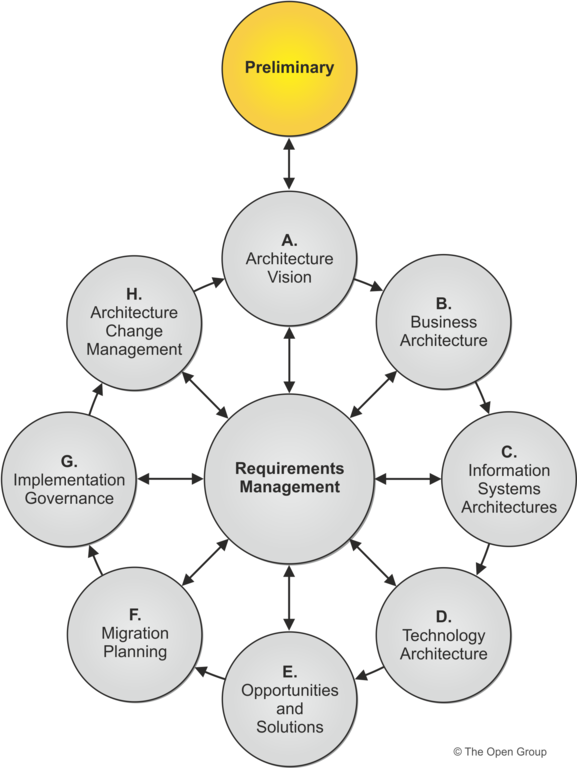TOGAF - ADM Preliminary Phase
Preliminary phase describes the preparation and initiation activities required to meet the business directive for a new Enterprise Architecture, including the definition of an Organization-Specific Architecture framework and the definition of principles.
I will follow TOGAF structure to describe ADM phases:

Preliminary Phase Objectives
The objectives of the Preliminary Phase are to:
-
Determine the Architecture Capability desired by the organization:
- Review the organizational context for conducting Enterprise Architecture
- Identify and scope the elements of the enterprise organizations affected by the Architecture Capability
- Identify the established frameworks, methods, and processes that intersect with the Architecture Capability
- Establish Capability Maturity target
-
Establish the Architecture Capability:
- Define and establish the Organizational Model for Enterprise Architecture
- Define and establish the detailed process and resources for Architecture Governance
- Select and implement tools that support the Architecture Capability
- Define the Architecture Principles
Preliminary Phase Inputs
- Reference Materials External to the Enterprise
-
Non-Architectural Inputs
- Board strategies and board business plans, business strategy, IT strategy, business principles, business goals, and business drivers, when pre-existing
- Major frameworks operating in the business; e.g., project/portfolio management
- Governance and legal frameworks, including Architecture Governance strategy, when pre-existing
- Architecture capability
- Partnership and contract agreements
-
Architectural Inputs
- Organizational Model for Enterprise Architecture, including:
- Scope of organizations impacted
- Maturity assessment, gaps, and resolution approach
- Roles and responsibilities for architecture team(s)
- Budget requirements
- Governance and support strategy
- Existing Architecture Framework, if any, including:
- Architecture method
- Architecture content
- Configured and deployed tools
- Architecture Principles
- Architecture Repository
- Organizational Model for Enterprise Architecture, including:
Preliminary Phase Steps
The steps within the Preliminary Phase are as follows:
- Scope the Enterprise Organizations Impacted
- Confirm Governance and Support Frameworks
- Define and Establish Enterprise Architecture Team and Organization
- Identify and Establish Architecture Principles
- Tailor the TOGAF Framework and, if any, Other Selected Architecture Framework(s)
- Develop a Strategy and Implementation Plan for Tools and Techniques
Preliminary Phase Outputs
The outputs of the Preliminary Phase may include, but are not restricted to:
-
Organizational Model for Enterprise Architecture, including:
- Scope of organizations impacted
- Maturity assessment, gaps, and resolution approach
- Roles and responsibilities for architecture team(s)
- Constraints on architecture work
- Budget requirements
- Governance and support strategy
-
Tailored Architecture Framework, including:
-
Tailored architecture method
- Tailored architecture content (deliverables and artifacts)
- Architecture Principles
- Configured and deployed tools
-
Initial Architecture Repository, populated with framework content
- Restatement of, or reference to, business principles, business goals, and business drivers
- Request for Architecture Work (optional)
- Architecture Governance Framework
The outputs may include some or all of the following:
- Catalogs:
Preliminary Phase Approach
Preliminary Phase is about defining "where, what, why, who, and how we do architecture" in the enterprise. The main aspects are as follows:
- Defining the enterprise
- Identifying key drivers and elements in the organizational context
- Defining the requirements for architecture work
- Defining the Architecture Principles that will inform any architecture work
- Defining the framework to be used
- Defining the relationships between management frameworks
- Evaluating the Enterprise Architecture maturity
References
You can find more information in The Open Group website. Specially in TOGAF "Part II - Architecture Development Method", chapter 5 Preliminary Phase
- Architecture Principles
- Architecture Maturity Models
- TOGAF template deliverables - Set 1
- TOGAF template deliverables - Set 2